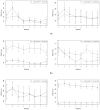Posture Estimation Using Surface Electromyography during Wheelchair Hand-Rim Operations
- PMID: 35590986
- PMCID: PMC9101678
- DOI: 10.3390/s22093296
Posture Estimation Using Surface Electromyography during Wheelchair Hand-Rim Operations
Abstract
This study examined competitive wheelchairs that facilitate sports participation. They can be moved straight ahead using only one arm. Our designed and developed competitive wheel-chairs have a dual hand-rim system. Their two hand-rims, attached to a drive wheel on one side, can be operated simultaneously for straight-ahead movement. Specifically, based on integrated electromyography (iEMG) data calculated from surface electromyography (sEMG), we examined the wheelchair loading characteristics, posture estimation, and effects on body posture during one-arm propulsion movement. The first experiment yielded insights into arm and shoulder-joint muscle activation from iEMG results obtained for two-hand propulsion and dual hand-rim system propulsion. Results suggest that muscle activation of one arm can produce equal propulsive force to that produced by two arms. The second experiment estimated the movement posture from iEMG during one-arm wheelchair propulsion. The external oblique abdominis is particularly important for one-arm wheelchair propulsion. The iEMG posture estimation validity was verified based on changes in the user body axis and seat pressure distribution. In conclusion, as confirmed by iEMG, which is useful to estimate posture during movement, one-arm wheelchair use requires different muscle activation sites and posture than when using two arms.
Keywords: assistive technology; competitive wheelchair; iEMG; muscle activation; parasports; sEMG; seat pressure.
Conflict of interest statement
The authors declare no conflict of interest.
Figures











Similar articles
-
Effect of power-assisted hand-rim wheelchair propulsion on shoulder load in experienced wheelchair users: A pilot study with an instrumented wheelchair.Med Eng Phys. 2015 Oct;37(10):961-8. doi: 10.1016/j.medengphy.2015.07.004. Epub 2015 Aug 22. Med Eng Phys. 2015. PMID: 26307457
-
Biomechanical analysis of wheelchair propulsion for various seating positions.J Rehabil Res Dev. 1992 Summer;29(3):12-28. doi: 10.1682/jrrd.1992.07.0012. J Rehabil Res Dev. 1992. PMID: 1640378
-
Quasi-static analysis of muscle forces in the shoulder mechanism during wheelchair propulsion.J Biomech. 1996 Jan;29(1):39-52. doi: 10.1016/0021-9290(95)00026-7. J Biomech. 1996. PMID: 8839016
-
Wheelchair propulsion biomechanics: implications for wheelchair sports.Sports Med. 2001;31(5):339-67. doi: 10.2165/00007256-200131050-00005. Sports Med. 2001. PMID: 11347685 Review.
-
Biomechanics and physiology in active manual wheelchair propulsion.Med Eng Phys. 2001 Dec;23(10):713-33. doi: 10.1016/s1350-4533(01)00083-2. Med Eng Phys. 2001. PMID: 11801413 Review.
References
-
- Gudrun D.T. The Paralympic Movement and the Olympics in Germany. J. Paralym. Res. Group. 2016;5:1–22.
MeSH terms
LinkOut - more resources
Full Text Sources

